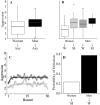Men's impulsivity underpins gender differences in aggressive behaviour
- PMID: 41068195
- PMCID: PMC12511576
- DOI: 10.1038/s41598-025-20114-6
Men's impulsivity underpins gender differences in aggressive behaviour
Abstract
The relationship between gender and aggression is multi-faceted, with survey research showing that the aggression varies with the gender of both aggressor and target. Here, using a lab-based paradigm that controls the capacity to cause harm and the risk of retaliation, we reveal pronounced gender-specific differences in aggression.Reactive aggression was assessed using a competitive reaction-time task that allowed dyadic pairs to interact face-to-face during conflict. Across two studies (n = 162/trials = 5099) same- and mixed-gender familiar pairs blasted each other repeatedly with noxious sounds, producing an oscillatory pattern of escalating and de-escalating aggression. Analysis revealed lower aggression in dyads made up of two women than mixed dyads or those made up of two men. Crucially, men were an order of magnitude more likely than women to initiate increases in aggression, and brief experimentally imposed delays designed to block impulsive behaviour significantly reduced male aggression. Put simply, when higher levels of aggression were seen, men (usually) started it.
© 2025. The Author(s).
Conflict of interest statement
Declarations. Competing interests: The authors declare no competing interests.
Figures







References
-
- Cross, C. P. & Campbell, A. Women’s aggression. Aggress. Violent. Beh.16, 390–398 (2011).
-
- Cross, C. P., Copping, L. T. & Campbell, A. Sex differences in impulsivity: a meta-analysis. Psychol. Bull.137, 97 (2011). - PubMed
-
- d’Acremont, M. & Linden, M. V. D. Adolescent impulsivity: Findings from a community sample. J. Youth Adolescence34(5), 427–435 (2005).
-
- Alexander, F., Allen, C., Brooks, J., Cole, C. & Campbell, A. Reason to believe: Representations of aggression as phenomenological read-out. Sex Roles51, 647–659 (2004).
MeSH terms
LinkOut - more resources
Full Text Sources
Miscellaneous

